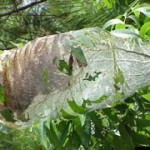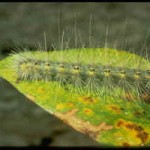San Antonio Express News
Gardening, ETC
Sunday, March 21, 2004
By Nathan Riggs, Extension Agent-IPM, Texas Cooperative Extension in Bexar County
As the warmer weather approaches, the fall webworm moth (Hyphantrea cunea) will soon be beginning its life cycle. Mid-to late May signals the beginning of the fall webworm season in Bexar County. Although the fall webworm begins its annual cycle in late spring, it develops through an average of three generations during the year in the San Antonio area, developing its largest population in the fall, which causes the heaviest damage and defoliates trees. Although trees experience heavy damage from webworms in the fall, it is the summer defoliations that cause the most stress on the trees. Summertime is when pecan trees are actively developing their nut crop and storing food for the winter in their roots. By the time defoliations occur in the fall, the impact to the tree is minimized because it has stored its winter food and produced its pecans. Fall webworms in South Texas prefer pecan trees to most other trees, but will munch on mulberry, hickory, oak, willow or redbud just as readily. The caterpillar, or webworm, is pale yellow or greenish in color, and is covered with long white hairs. The webs are made by groups of caterpillars hatched from the same egg mass. Webworm caterpillars and moths are active at night when most of their predators (paper wasps, hornets, and birds) are inactive. The caterpillars feed on leaf material and leave the stems and veins behind. Although these caterpillars are hairy, they do not sting; however, they can cause an irritating rash if their hairs come in contact with human skin.
- White Webworm Moth and Pupa Stage
- Webworm Web in Tree
- The Notorius Webworm
The fall webworm moth emerges from its cocoon in late spring and deposits white, “cottony” egg masses on the undersides of leaves. During this time, webworm eggs are especially vulnerable to attack by microscopic wasps called Trichogramma. These wasps are so small (1/50th of an inch!) that five of them can fit on the head of a pin! Trichogramma wasps attack by seeking out webworm egg masses throughout the tree and laying their own eggs inside those of the webworm. One female wasp can parasitize up to 100 webworm eggs during her short lifetime and will kill many more by directly feeding on them. The wasp egg hatches and the wasp larva feeds on the contents of the webworm egg. Once it has consumed these contents, it produces a tiny cocoon inside of the egg and changes to an adult wasp. These new adult wasps hatch out of their parasitized webworm eggs and fly away to attack more webworm eggs. The whole process from laying an egg inside of the webworm egg until the adult wasp emerges from that webworm egg is 8 to 10 days.
Trichogramma wasps can be purchased from local Texas insectaries (Biofac Crop Care, Mathis, TX, http://www.biofac.com or Kunafin Insectary, Eagle Pass, TX, http://www.kunafin.com for release in home gardens and landscapes. They come as sets of 5,000 parasitized caterpillar eggs glued to a small card. These eggs will produce wasps within 2 to 4 days in most cases. To release them, simply place the card into the branches of trees and affix them with some string, a wire or other attachment. The cards should be placed out in early morning or evening when direct sunlight will not hit the cards. Trichogramma wasps are used in row crop agriculture to assist farmers in controlling crop pests. Their effectiveness in crops, if released in high-enough numbers, has been documented successfully across the United States by state universities and other related research entities. In urban areas, however, there are no data concerning the effects of releasing Trichogramma for webworms in pecan trees. One new program seeks to examine what effect a coordinated Trichogramma release effort would have on webworms in selected areas.
The City of San Antonio, Texas Forest Service, Texas Cooperative Extension, Bartlett Tree Care and City Public Service have joined together to examine the effectiveness of releasing Trichogramma wasps into pecan trees as a way to slow down the rampant explosions of webworms seen in San Antonio over the past 2 to 3 years. Four city park areas will be targeted for this study with releases being conducted in mid to late April and again in mid to late June.
If you missed the Texas Community Futures Forum to identify key issues for Bexar County that was held March 3, you can still provide your input by visiting the website.
The website address is http://futuresforum.tamu.edu. You are invited to visit the website and contribute input until March 31. This information will help Texas Cooperative Extension and the Cooperative Extension Program plan educational strategies for the next four years. Thank you in advance for your participation.
This article was written by Nathan Riggs, IPM Extension Agent with Texas Cooperative Extension in Bexar County.


